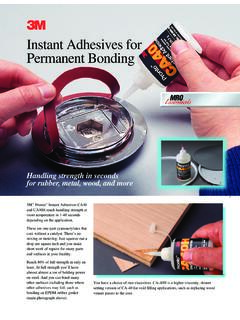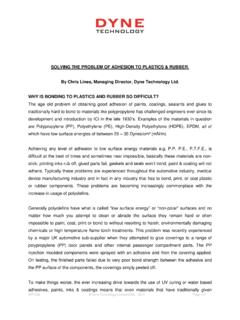Transcription of A Guide To Handling and Application - ChemRep
1 ADHESIVESAPPLICATION Guide A Guide To Handlingand ApplicationGeneral Overview .. 3 Packaging .. 3 Substrate Preparation .. 3 Types of Surface Preparation .. 3 General Surface Preparation .. 4 Preparation Methods for Various Substrates .. 4 Steel .. 4 Stainless Steel .. 4 Aluminum .. 4 Magnesium .. 5 Brass and Copper .. 5 Zinc .. 5 Plated Metals .. 5 Plastics .. 5 Miscellaneous Substrates .. 5 Selecting a Preparation Method .. 5 Maintenance of Surface Properties .. 6 Applying Chemlok Solvent-based Adhesives .. 7 Preparing the Adhesive.
2 7 Applying the Adhesive .. 7 Hand Brushing .. 7 Dip Application .. 8 Spray Application .. 9 Spray Equipment .. 9 Roll Coating .. 10 Drying Processes .. 10 Handling Coated Parts .. 10 Coated Parts Layover Stability ..11 Proper Storage .. 11 Applying Chemlok Aqueous Adhesives .. 12 Differences Between Solvent-based and Aqueous Adhesive Systems .. 12 Benefits of Aqueous Systems ..12 Preparing the Adhesive .. 12 Applying the Adhesive .. 12 Spray Application ..12 Spray Equipment .. 13 Dip Application .. 14 Automatic Systems .. 15 Brushing.
3 15 Roll Coating .. 15 Pad Painting .. 15 Accelerating Drying Time .. 15 Monitoring .. 17 Storage .. 17 Coated Parts Layover Stability .. 18 Post-Treatment .. 19 Troubleshooting .. 19 Safe Handling .. 20 Lord applications Laboratory .. 20 Service and Equipment Suppliers .. 21 TABLE OF CONTENTS3It s been more than 40 years sinceChemlok rubber -to- metal adhesives were firstintroduced. While much has changed duringthis time, one thing remains constant: thequality of Chemlok adhesives. Today asfrom the beginning the Chemlok family isrecognized as the industry leader in rubber -to- metal adhesives.
4 That s why when manufactur-ers have a critical Application that demands aproven rubber -to- metal adhesive, they look toChemlok a premium adhesive is the basisof a quality bond, it s only the beginning;proper Application is essential for maximumresults. Whether you re dipping or spraying,using solvent-based or aqueous Chemlokproducts, you ll learn how to maximizeefficiency and optimize results. This Guide willalso show you how to troubleshoot commonbond problems, and find names and numbersof materials and equipment recommend you read this entirebooklet before using Chemlok adhesives;however, we realize that many of our custom-ers have been using our products for years,and reading this Guide from cover to coverisn t necessary.
5 Regardless, we hope thisresource will become an indispensable part ofyour operation and a convenient, one-sourcesolution to many of your bonding think of it as an extension of LordCorporation, and remember: When it s critical,it s solvent-based and aqueousadhesive systems are available in several sizesto accommodate varying production require-ments. Choose from one of these convenientpackages: Quart containers 1-gallon pails 5-gallon pails 55-gallon, phenolic-lined metal drums withagitator paddlesSubstrate PreparationOne of the most important steps to aquality bond is substrate preparation.
6 Toensure optimum bond performance and long-term environmental resistance, substratesmust be free of organic and inorganic contami-nants. Organic materials, which can beremoved by solvent or alkaline cleaning,include grease, dirt and oils. Common inor-ganic pollutants are rust, scale and oxidelayers. These contaminants can be cleaned byabrasion or chemical processes, or a combina-tion of of Surface Preparation There area number of ways to prepare substrates foradhesive Application ; however, the methodscan be broadly divided into mechanical andchemical.
7 Regardless of which method youchoose, the essentials of all good surfacepreparations include: Removal of all surface contaminants anddecomposition products. Prevention of recontamination. Careful Handling through all preparation involves physi-cally removing surface contamination andincreasing surface area and substrate methods include: Blasting Abrasive particles (sand, grit ormetal oxides) are projected against thesurface with a stream of air. Blasting isespecially effective for removing inorganiccontamination and other corrosion com-pounds found on metal .
8 The character orquality of the treatment is affected byduration of the blast; shape and size of theblasting media; particle velocity; and thehardness, porosity and other properties ofthe substrate. Abrading A wire brush or abrasive paperor pad is used to grind the surface. Caremust be taken to prevent contamination ofthe abrasive material and to remove dustand particles after use. Machining Cutting tools are used to score surfaces. If oils are completelyremoved, machining produces an excellentbonding surface. However, any oil left on themetal surface may cause poor processes, on the other hand,utilize organic and inorganic chemicals todissolve, suspend or eliminate soils andsurface contaminants.
9 Preparations include: Vapor/solvent degreasing The vaporof solvent or alkaline cleaning solutionis utilized to eliminate organic contamination or oils. Because degreasing willnot remove scale or corrosion, it s bestto use in conjunction with blasting formetal OVERVIEW4 Anodizing Aluminum oxides are electro-lytically deposited on bonding surfaces. Passivation Zinc phosphating Alkaline cleaning Chromate alodizing Chemical etching PicklingGeneral Surface Preparation Whetheryou re using Chemlok solvent-based oraqueous adhesive systems, the following three-step process is the preferred mechanicalsurface preparation technique:1.
10 Degreasing2. Grit-blasting3. DegreasingWhile the above methods produceexcellent surfaces for bonding most substrates,more elaborate chemical methods may beneeded for certain substrates or for improvedenvironmental resistance. Details on specificmethods are described under the heading forthe specific of the system you choose,parts must remain clean when being removedfrom the cleaning tank. Water break tests(ASTM F22) should be performed regularly tocheck purification Methods For VariousSubstrates Although the general prin-ciples are the same for preparing all sub-strates, some materials require specialattention.









